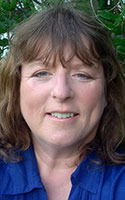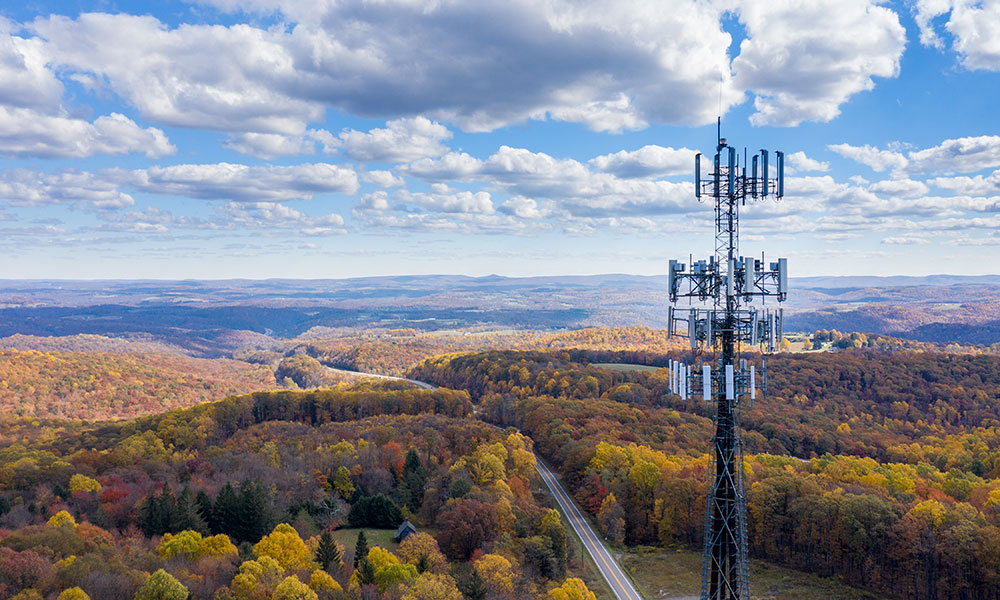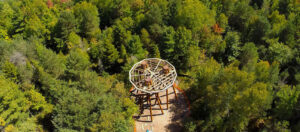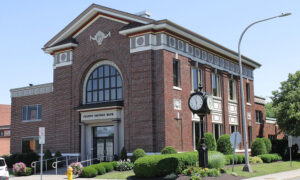Reliable high-speed internet often remains out of reach for rural CNY communities
By Ken Sturtz
![Christopher Ali is a media studies professor at the University of Virginia who researches rural and broadband issues. “This issue [of internet access] is particularly apparent in rural America,” he says.](https://www.oswegocountybusiness.com/wp-content/uploads/2021/09/Christopher-Ali-Portraits-249.jpg)
When Stephanie Michalski and her husband were house hunting, access to high-speed internet was almost an afterthought.
In 2019, they purchased a house in Nedrow, within sight of Interstate 81. Their previous home had been serviced by Verizon Fios, which provided ultra-fast fiber optic internet. But Michalski says she wasn’t concerned because the listing for the house said broadband was available.
“We didn’t know there was no internet here until we closed on our house and called Spectrum to be told our address isn’t serviceable,” she says.
Even though neighbors in the surrounding area had access to Spectrum internet, Michalski was stunned to discover that the nearest terminal was about half a mile away. She was told it would cost $40,000 out of pocket to run coaxial cable to their house.
“We were told there’s not enough houses on our street to make it worth their while to run the lines,” she says.
Such is the state of broadband in rural communities throughout much of the United States. The federal government claims that most of rural America has broadband internet, but vast numbers of people either still lack broadband or are underserved. Many rural areas lack the underlying infrastructure needed to support broadband. And in places where broadband is available, the high cost sometimes puts it out of reach.
Central New York is no exception.
In theory New York has made great strides over the past decade to bring broadband to even the most remote corners of the state. In practice, however, many New Yorkers have been left behind in a growing digital divide.
Rural vs. Urban
While the percentage of Americans with broadband access has steadily crept up, the digital divide between rural communities and suburban and urban communities has continued growing despite efforts to extend broadband access. Indeed, the federal government collectively spends billions of dollars each year on rural broadband infrastructure.
In many ways the issues with rural broadband closely parallel the challenges of electrifying rural America in the early 20th century, says David Danbom, a retired professor who has written several books on American agriculture and rural life.
Early on, most residents in towns and cities had central station power, but in the country people generally didn’t have electricity unless they had their own electrical plant or were close enough to a town to extend the lines to their home.
By the 1920s and 1930s, however, electricity came to be defined as a necessity for modern people.
“And really in a lot of ways it’s like the internet today,” Danbom says. “It’s increasingly difficult to get along without it.”
Much like broadband today, in the 20th century the federal government stepped in and bankrolled rural electric co-ops and provided low-interest loans to farmers who wanted to electrify their farms and to people who wanted to purchase electric appliances. The push to electrify the countryside, like extending broadband, didn’t happen overnight. By the early 1950s, however, all but the most remote areas of the U.S. had electricity.
Unfortunately, extending broadband has proven more complicated. One of the major policy failures has been how broadband is actually defined, says Christopher Ali, a media studies professor at the University of Virginia who researches rural and broadband issues.
The Federal Communications Commission defines a broadband internet connection as having a minimum download speed of 25 megabits per second (Mbps) and a minimum upload speed of 3 Mbps. At that speed — commonly referred to as 25/3 Mbps — a household could stream a movie and post on social media at the same time without slowing down. Many households have connections much faster than the FCC threshold for broadband. The average speed in the U.S. in 2018 was 96/32 Mbps.
But is 25/3 Mbps sufficient to be called broadband?
That question is at the heart of a major policy fight. The FCC hasn’t changed its definition of broadband since 2015. Ali, whose forthcoming book “Farm Fresh Broadband: The Politics of Rural Connectivity,” focuses on broadband policy, says when he testified earlier this year before the U.S. Senate he argued that 25/3 Mbps is too slow to be considered broadband.
In theory New York has made great strides over the past decade to bring broadband to even the most remote corners of the state. In practice, however, many New Yorkers have been left behind in a growing digital divide.
“There’s a lot of politicking involved in broadband,” Ali says. “The Federal Communications Commission likes to keep that definition low because it means that the digital divide, it looks like it’s shrinking because more Americans can be said to be connected to a network even if that network is not particularly good.”
There are several ways to deliver broadband, the most desirable being ultra-fast fiber optic. It can handle nearly unlimited data, but is expensive to install and can cost $27,000 a mile, Ali says.
The next best option is coaxial cable, which is more reasonably priced and offers great download speeds and decent upload speeds. It’s the most common broadband technology in the U.S., but can be hindered by network consumption, meaning if everyone in your neighborhood is watching Netflix at the same time, you might experience a slowdown. There’s also fixed wireless, which usually involves running a fiber optic cable to a tower to transmit internet connectivity to households, kind of like a giant Wi-Fi community. Speeds can be decent and the technology can be useful in rural communities that area spread out.
The other technologies for delivering internet — dial-up, satellite and DSL — are more problematic. Dial-up has been virtually abandoned in the U.S. due its slow speed. Under the FCC’s 25/3 Mbps threshold, however, satellite internet and DSL continue to count as broadband.
Satellite internet can be adequate in some circumstances, but is heavily dependent on the weather, Ali says. DSL isn’t particularly good at delivering the data speeds a contemporary household needs because it relies on traditional copper telephone lines. It’s still fairly common in rural America because phone companies are reluctant to make expensive infrastructure upgrades; network conditions greatly affect DSL speed.
But since satellite and DSL are capable of supporting speeds of 25/3 Mbps, a household with access to one of them is considered to have broadband.
That was the case for Michalski, whose mailing address is Nedrow, but lives in the LaFayette school district.
When she and her husband moved into their new home in 2019 they didn’t know that Spectrum wouldn’t run the internet to their house. The only wires running to their house were the electrical lines.
They still had options for the internet, just not any good ones.
She and her husband researched satellite internet, but the strict data caps and high price made it unrealistic, especially since satellite was unlikely to be able to handle streaming video. They considered purchasing a personal hotspot, but that also came with restrictive data caps and would have been extremely expensive, she says.
The internet situation was so bad that Michalski says it even affected her husband’s job. He worked in IT and a large part of his job involved being on call for after-hours services. He tried to use a computer at his parents’ home in Kirkville, but eventually decided he couldn’t do the job without reliable internet and changed professions.
The family’s saving grace is that they have good cell phone service, which remains their only reliable means to access the internet. Even that’s not an ideal solution since it’s hard to get and keep a strong enough signal to use a laptop or desktop computer.
“We were used to having multiple devices running all day long and now we have nothing,” she says. “In some ways it’s nice because the kids can’t sit and play games all day long.”
During the pandemic, however, lack of internet was isolating, preventing the family from connecting and socializing with other people. They couldn’t talk with friends about the most popular television shows people were binge-watching at the time. Schoolwork became especially difficult. During the pandemic the LaFayette schools loaned them a hotspot so Michalski’s children could learn and do work remotely. But the internet still lagged and disconnected often.
“So that hasn’t been easy either,” she says. “That’s not foolproof.”
Unfortunately, there’s no truly accurate count of how many households are like Michalski’s. On paper of course, most Americans, even in rural communities, have access to broadband. The FCC estimates that slightly more than 26% of rural America, of 16.9 million people, still lacks access to a broadband connection. But the FCC’s estimates have proven to be far from accurate due to the way the agency collects data on broadband access.
“We actually do not know who is connected and who is not connected, nor do we know who is under-connected and that’s because the broadband deployment maps are awful,” Ali says.
Broadband Now, an independent research group whose data is frequently cited, examined flaws in the FCC’s estimates of how many Americans lack access to broadband internet. The FCC’s Broadband Deployment Report states that 21.3 million Americans, or 6.5% of the population, lack access to broadband.
That figure relies on semi-annual self-reporting by internet service providers. As Broadband Now noted, however, the reporting system includes a widely acknowledged flaw: if an ISP offers service to at least one household in a census block, then the FCC counts the entire census block as having coverage. Broadband Now manually checked internet availability using FCC data as the source of truth for randomly selected addresses. Based on its research, the group concluded in a study released this year that 42 million Americans don’t have access to wired or fixed wireless broadband. In New York state the estimate was 640,000, twice the FCC estimate.
Central New York and Oswego County

Central New York again is no exception. An infrastructure analysis report commissioned by Oswego County reached a similar conclusion regarding broadband access. Three companies — Verizon, Windstream and Spectrum – together provide wireless and broadband coverage for more than 92% of the county.
“Although providers indicate that their coverage extends across most of Oswego County, stakeholders have suggested otherwise,” the report says. In addition, a crowdsourcing campaign led by Sen. Chuck Schumer reported a total of 118 wireless dead zones in Oswego County, leading the Central New York region.
The situation is so confusing that earlier this year the Central New York Regional Planning and Development Board launched a survey asking businesses and residents in five counties to share information about the quality of their internet access. The survey is meant to give municipal leaders a better picture of underserved areas.
Ray Nellis and his wife lived in one of those underserved areas in Oswego County for three decades. Their house is on the edge of Hastings, near the Mexico town line. They used DISH for television, but high-speed internet was extremely difficult to access in their neighborhood.
Nellis says his wife, who works in life insurance, needed reliable internet to do her job from home, so they spent $120 a month on a hotspot device. The hotspot worked most of the time, but they frequently went over the data limits and ended up paying extra.
“We were always going over on usage,” Nellis says. “I’d watch highlights of a ball game and my wife would be yelling at me.”
When Spectrum ran a cable line down their road a few years ago, Nellis says he and his wife decided to make the switch and chose a package that included unlimited data. They haven’t gone over on data since and Nellis says he watches all the baseball games he wants — not just the highlights — without fear of being up-charged.
Caron Chapman-Case has struggled for access to high-speed internet for years and before that suffered similar problems with the telephone. She’s lived on her family’s small dairy farm in Tully for most of her life.
The 56-year-old remembers as a child that when her father needed to call the vet he sometimes couldn’t get through because the line was dead, which meant a trip down the road to use the neighbor’s phone.
In addition to phone trouble they never had access to reliable high-speed internet despite living on a state highway. Chapman-Case says that she paid for a landline telephone and dial-up internet for many years, but that the service was extremely unreliable. About a decade ago she switched to satellite internet. The price was reasonable and even though the service wasn’t reliable — the internet never worked when it rained or snowed, or on major holidays — it was a marked improvement over dial-up.
“We just knew on Christmas Eve don’t plan on sitting down and watching a movie,” she says.
Their satellite provider eventually went away and most of the neighbors on their road switched to using their cell phones, Chapman-Case says. Her family began using their cell phones when they could and tried several brands of hotspots that cost as much as $100 a month and came with data limits. She says Spectrum, which is running cable nearby in Otisco, told her it would cost $30,000 to run a cable to her house.
Last summer, Chapman-Case’s daughter had a paid college internship doing research online. She’d hoped her daughter could use the local libraries while she was home, but they closed down during a portion of the pandemic. Running a simple Zoom meeting meant a trip to the parking lot of the library or the nearby Burger King to use their Wi-Fi. Her daughter was able to finish her internship using borrowed hotspots from the library.
So why has the expansion of rural broadband been slow and left so many people behind? Some rural areas still don’t have the infrastructure to support broadband and finding someone willing to build that infrastructure is difficult.
“This issue is particularly apparent in rural America and that’s largely because the large internet service providers — who are often the largest telecommunications companies or largest cable companies — don’t see the return on investment to deploy in rural America,” Ali says.
Rural areas tend to be sparsely populated, which makes rolling out broadband infrastructure very expensive and makes it difficult to find companies to make the investment.
In 2016, the state Public Service Commission approved the merger of Charter (Spectrum) with Time Warner Cable, which made Charter the largest cable company in the state and the second-largest in the U.S. The approval came with the caveat that Charter agree to extend service to 145,000 unserved and underserved homes within four years. Whether Charter lived up to its obligations has been a source of intense controversy.
“It’s an interesting case in New York, particularly with Charter Spectrum because they made all of these promises when they bought Time Warner Cable, particularly in New York State, and heretofore they have not lived up to these promises,” Ali says.
Charter has continued to expand service, but in areas where it has promised to build out the internet it’s claimed federal subsidies, even if it hasn’t built out the internet yet. That means that if a competitor wants to extend internet service to the same area, they have to do it without federal support, Ali says.
“And so, what happens is these kinds of quasi-rural, but not remote areas are just left completely underserved,” he says.
The pandemic has brought renewed attention to the issue of broadband access, especially after millions of Americans spent months stuck at home with the internet as their main lifeline for entertainment, education and employment.
A crowdsourcing campaign led by Sen. Chuck Schumer reported a total of 118 dead zones in Oswego County, leading the Central New York region in lack of access to reliable internet.
President Joe Biden’s proposed infrastructure package would direct tens of billions of dollars toward improving broadband access, particularly in rural communities.
Michalski hopes the situation improves in the future. She wrote a letter to County Executive Ryan McMahon about the issue after he pledged to spend some of Onondaga County’s share of federal stimulus money toward extending broadband. She’s also signed up on the waitlist for Starlink, billionaire Elon Musk’s project to bring high-speed internet everywhere using a constellation of satellites.
Those solutions are likely years off, however. For now, many people who are underserved, like Chapman-Case, have had to be satisfied that things have improved slowly over time.
A few years ago, the local libraries began lending hotspots purchased through a grant program and Chapman-Case says that those devices combined with their personal hotspot helped somewhat. But her family still doesn’t have access to reliable high-speed broadband.
“Things are getting better, but we’re kind of unhappy that we’ve been left in the dark,” she says.




